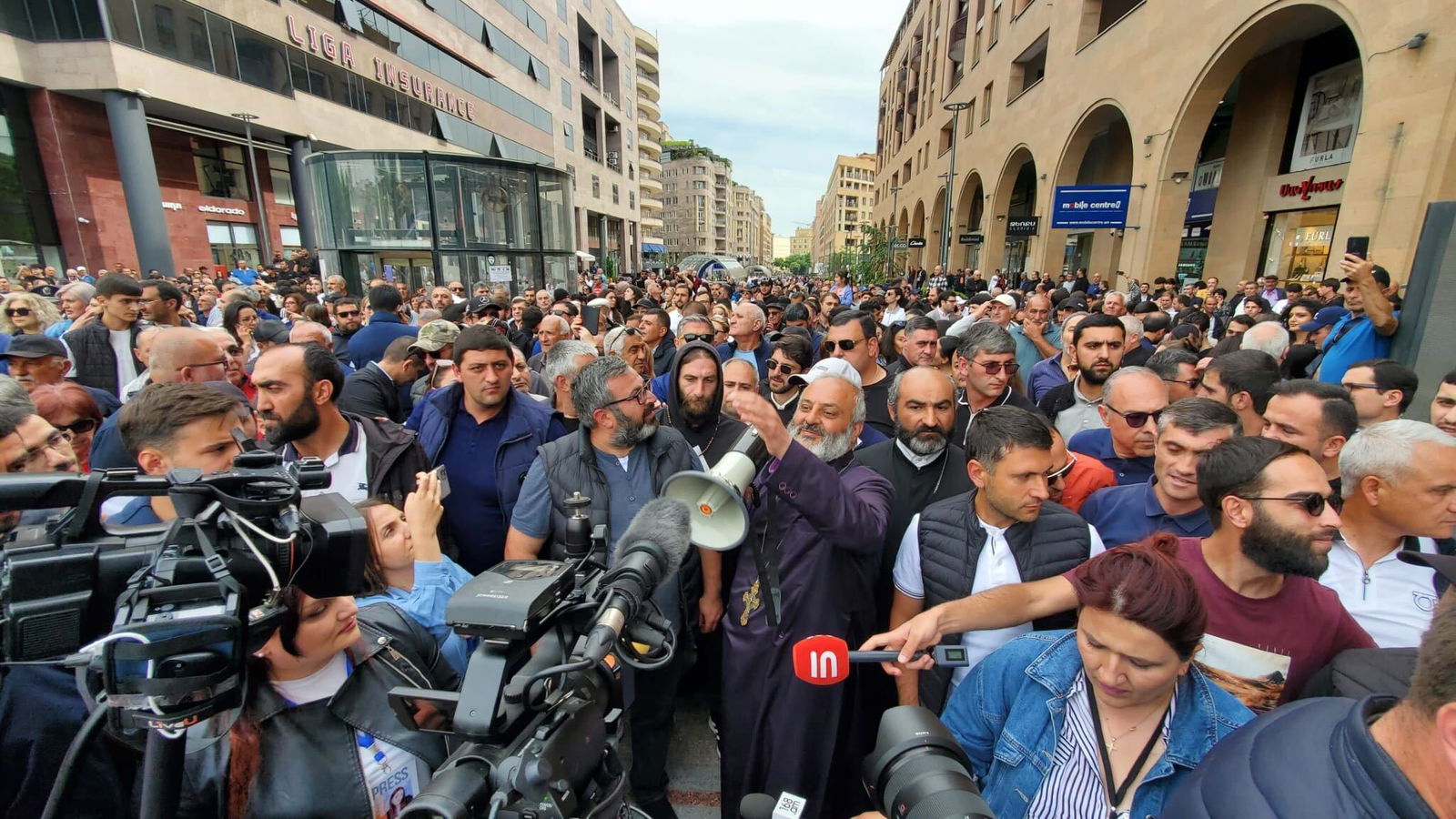 Thousands of “Tavush for the Homeland” supporters march toward the Opera House on Wednesday, May 15, 2024 (Photo: Hoory Minoyan)
Thousands of “Tavush for the Homeland” supporters march toward the Opera House on Wednesday, May 15, 2024 (Photo: Hoory Minoyan)
YEREVAN—Today marks the critical deadline for Armenia and Azerbaijan to sign the demarcation protocol for the Tavush region. According to the agreement reached on April 19 between the Armenia and Azerbaijan border delimitation commissions, the parties agreed to finalize a protocol by May 15. The initial phase of the process has seen preliminary agreements on specific sections of the border, including Baghanis-Baghanis Ayrum, Voskepar-Ashagh Askipara, Kirants-Kheirumli and Berkaber-Kyzyl Hajil. The agreement states that the demarcation process must comply with the inter-republican borders that existed at the time of the USSR’s dissolution.
The April 19 agreement states that detailed descriptions of these border sections, based on geodetic measurements, would be documented in a protocol to be signed by today. However, the demarcation process experienced a temporary freeze last week when discussions were moved to Yerevan due to ongoing protests by the “Tavush for the Homeland” movement. This movement, led by Archbishop Bagrat Galstanyan, has held daily protests in Yerevan since May 9 after a march from Kirants in opposition to the handover of Armenian lands.
In Kirants, a border village in Tavush, border posts have been placed in the lowland areas. Prime Minister Nikol Pashinyan informed residents that the village would be divided and the bridge handed over to Azerbaijan. Residents of Kirants report that three border pillars remain to be installed. Today’s decisions will reveal whether the authorities will sign the protocol without dividing the village or proceed with placing the pillars in the middle, effectively splitting it.
The demarcation process has raised significant defense concerns. Former Deputy Head of the Defense Ministry Tiran Khachatryan has warned that the withdrawal of the Armenian Armed Forces from border areas could create a defense gap, making it easier for Azerbaijani forces to penetrate deeper into Armenian territory.
The “Tavush for the Homeland” movement has been actively protesting the planned land handover, with acts of civil disobedience staged throughout Yerevan since May 9. Today, the “Tavush for the Homeland” movement organized a march to Freedom Square, where PM Pashinyan participated in an event at the Spendiaryan National Academic Theater of Opera and Ballet as part of the EBRD International Forum.
Following the announcement of demonstrations, a large police presence was sent to Freedom Square. To ensure PM Pashinyan’s entrance to the theater, movement and car traffic were restricted and police barriers were set up throughout the square. Several cafes in Freedom Square were also closed.
 Archbishop Bagrat Galstanyan leads the “Tavush for the Homeland” protests on May 15, 2024 (Photo: Rupen Janbazian)
Archbishop Bagrat Galstanyan leads the “Tavush for the Homeland” protests on May 15, 2024 (Photo: Rupen Janbazian)
“I want to thank the police for closing the streets for you,” Archbishop Galstanyan said, referring to the roadblocks set up by protesters throughout the week on major highways, including the Armenia-Iran interstate highway and the Sevan-Yerevan highway. Hundreds of people have been detained throughout the protests, including at least 151 on May 13 and 63 on May 14.
During a massive rally on May 12 in Yerevan’s Republic Square, which was filled with tens of thousands of supporters, Archbishop Galstanyan articulated the movement’s stance, stating, “We are not opposed to peace, delimitation or demarcation. However, what is currently happening, with unilateral concessions forcing us to our knees, is unacceptable. There is no precedent for repeatedly giving in without guarantees against war, especially under the threat of force. We seek definitive peace, a peace that is worthy and lasting.”
During the May 9 rally, when the movement arrived in Yerevan, Archbishop Galstanyan demanded PM Pashinyan’s resignation, declaring, “Nikol Pashinyan, you have one hour to resign. I am ready to meet and discuss all conditions of departure. You no longer have any form of authority in the Republic of Armenia.”
The ruling Civil Contract party’s parliamentary faction responded swiftly, posting images on social media of Pashinyan with the caption, “Elected Prime Minister of the Republic of Armenia Nikol Pashinyan.” Despite this, Archbishop Galstanyan vowed to compel Pashinyan’s resignation through a vote of no confidence in the National Assembly, engaging with all political factions.
According to the “Regulations of the National Assembly” law, initiating the impeachment process requires 36 signatures, one-third of the total number of deputies. The opposition presently has 35 MPs and needs one more vote. Ishkhan Zakaryan, who left the “I Have Honor” faction, holds independent deputy status and has been approached by Archbishop Galstanyan.
Once the process is initiated, the opposition must present a candidate for the prime minister position. Artur Khachatryan, a deputy of the Hayastan faction, said that after gathering the necessary 36 signatures, a vote must be held within 48-72 hours. The impeachment process requires at least 54 votes, meaning the opposition would need to secure an additional 18 deputies. Leaders of the movement aim to achieve this by intensifying street protests.
At the rally held on May 12, Archbishop Galstanyan outlined a vision for a transitional government, focusing on national reconciliation, stability and democratic principles. He proposed an inclusive government involving capable professionals from various backgrounds, fostering an atmosphere of justice and reconciliation.
The public administration should be stable and free from nepotism, he argued, ensuring free and fair elections without immediate constitutional changes. He also said that it should continue peace negotiations with Azerbaijan and develop an independent foreign policy, rejecting external pressures.
Emphasizing the unique challenges faced by Armenia, the archbishop called for the integration of experienced specialists, a new strategy for engaging the Diaspora and a focus on post-war recovery.
The archbishop added that controversial programs should be halted, political prisoners released and a new military doctrine developed. The economy should be made self-sufficient, with a focus on resource management and ecological balance. Education should aim to create virtuous individuals, with knowledge driving economic growth. Human rights, citizen liberties and democratic values should be prioritized, paying special attention to national minorities. The archbishop said that this comprehensive approach would stabilize and advance Armenia during the transitional period.
Archbishop Galstanyan continues to lead the movement, calling for peaceful gatherings and summarizing daily activities each evening at St. Anna Church. He has criticized the police for their aggressive tactics against protestors and journalists, arguing that they have been instructed to intimidate and terrorize citizens.
Author information
Hoory Minoyan
Hoory Minoyan was an active member of the Armenian community in Los Angeles until she moved to Armenia prior to the 44-day war. She graduated with a master’s in International Affairs from Boston University, where she was also the recipient of the William R. Keylor Travel Grant. The research and interviews she conducted while in Armenia later became the foundation of her Master’s thesis, “Shaping Identity Through Conflict: The Armenian Experience.” Hoory continues to follow her passion for research and writing by contributing to the Armenian Weekly.
The post “Tavush for the Homeland” protests continue against planned land concessions appeared first on The Armenian Weekly.
